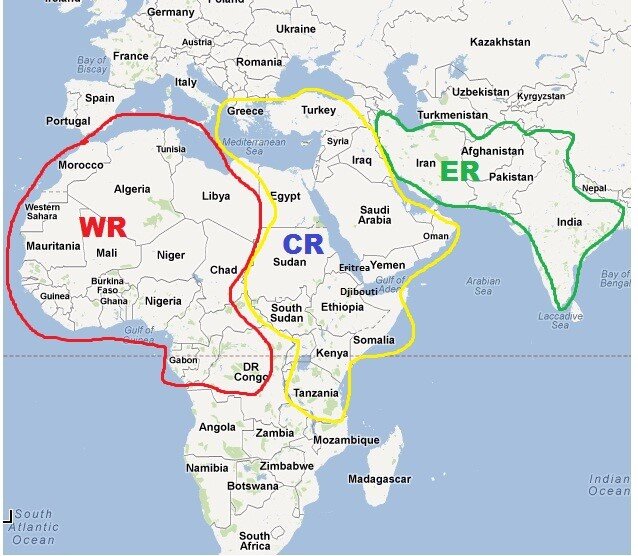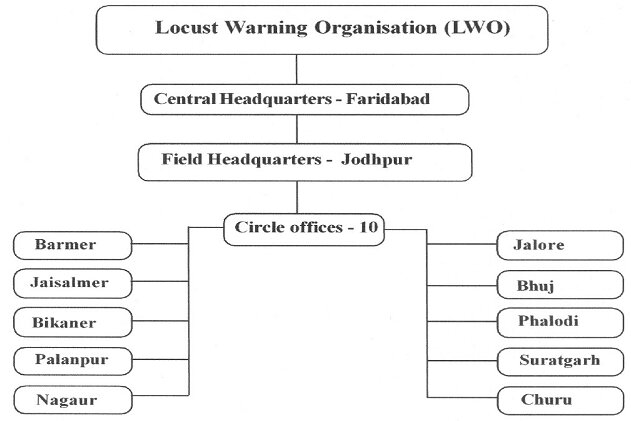Anti Locust Fight | 03 Jul 2019
The officials from India and Pakistan are closely working together to prevent the movement of locusts and save crops in bordering districts.
- Both the countries are also consistently sharing inputs, including satellite data, via Food and Agricultural Organization (FAO) to counter and restrict the movement of locusts.
Food and Agricultural Organization
- In 1945, Food and Agriculture Organization (FAO) was created In Quebec City, Canada, by the first session of the newly created United Nations.
- FAO is a specialized agency of the United Nations that leads international efforts to defeat hunger.
- FAO is also a source of knowledge and information, and helps developing countries in transition modernize and improve agriculture, forestry and fisheries practices, ensuring good nutrition and food security for all.
Locust
- A locust is a large, mainly tropical grasshopper with strong powers of flight. They differ from ordinary grasshoppers in their ability to change behaviour (gregarize) and form swarms that can migrate over large distances.
- Locusts are generally seen during the months of June and July as the insects are active from summer to the rainy season.
- Locusts have a high capacity to multiply, form groups, migrate over relatively large distances (they can fly up to 150 km per day) and, if good rains fall and ecological conditions become favourable, rapidly reproduce and increase some 20-fold in three months.
- Threat to Vegetation: Locust adults can eat their own weight every day, i.e. about two grams of fresh vegetation per day. A very small swarm eats as much in one day as about 35,000 people, posing a devastating threat to crops and food security.
- If infestations are not detected and controlled, devastating plagues can develop that often take several years and hundreds of millions of dollars to bring under control with severe consequences on food security and livelihoods.
- Locust Control measures include destroying egg masses laid by invading swarms, digging trenches to trap nymphs, using hopperdozers (wheeled screens that cause locusts to fall into troughs containing water and kerosene), using insecticidal baits, and applying insecticides to both swarms and breeding grounds from aircraft.
- FAO provides information on the general locust situation to the global community and gives timely warnings and forecasts to those countries in danger of invasion.
- The FAO raised alarm over the locust outbreak in northeast Africa and Saudi Arabia in February, 2019.
Locusts in India
- Four species viz. Desert locust (Schistocerca gregaria), Migratory locust (Locusta migratoria), Bombay Locust ( Nomadacris succincta) and Tree locust (Anacridium sp.) are found in India.
- The existing series of locust swarms that have entered India via Pakistan had originated in Iran. Movement of locusts is facilitated by summer dusty winds, which flow from the Arabian Sea, taking along these creatures from Sindh in Pakistan to western Rajasthan.
- These creatures have wreaked havoc in Pakistan but have not caused any damage on the Indian side.
- Locust Warning Organisation (LWO), Jodhpur is currently handling 13-16 swarms of locusts in Jaisalmer and Barmer districts of Rajasthan. It is currently using a pesticide 'malathion'.
- The last major locust outbreak that was reported in Rajasthan was in the year 1993.
Locust Warning Organization ( LWO)
- Locust Warning Organisation (LWO), Directorate of Plant Protection Quarantine and Storage, Ministry of Agriculture & Farmers Welfare, is responsible for monitoring, survey and control of Desert Locust in Scheduled Desert Areas mainly in the States of Rajasthan and Gujarat.
- Incursion of exotic locust swarms into India is prevented through organization of suitable control operation. LWO keeps itself abreast with the prevailing locust situation at National and International level through monthly Desert Locust Bulletins of FAO.
- Its objectives include:
- To monitor, forewarn and control locust in Scheduled Desert Area (SDA) being International obligation and commitment.
- To conduct research on locust and grasshoppers.
- Liaison and coordination with National and International Organizations.
- Human resource development through training and demonstration for staff of Locust Warning Organization (LWO), State officials, BSF personnel and Farmers.
- To maintain control potential to combat locust emergency by organizing locust control campaign.


